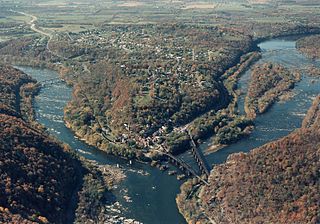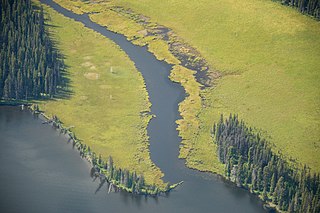
Maquinna Marine Provincial Park is a provincial park in British Columbia, Canada, located northwest of Tofino in the Clayoquot Sound region of the West Coast of Vancouver Island, protecting Ramsay Hot Springs, which is the name-source of the cove, settlement and former post office of Hot Springs Cove.
Gilford Island is an island in British Columbia, Canada, located between Tribune Channel and Knight Inlet. The island has an area of 382 square kilometres (147 sq mi). Turnour Island is to the south across Tribune Channel, the entrance to Thompson Sound to the east.
Kimsquit is a former village of the Nuxalk at the mouth of the Dean River on the northeast side of Dean Channel in the Central Coast region of British Columbia, Canada. Kemsquit Indian Reserve No. 1 is nearby at 52°49′00″N126°58′00″W, which is on Kimsquit Bay; Kimsquit Mountain is nearby.
The Nusatsum River is a river in the Bella Coola Valley of the Central Coast region of British Columbia, Canada. It is a tributary of the Bella Coola River, flowing northwest to meet that river just upstream of the community of Hagensborg.
Defiance Mountain 2666 m is a mountain in the northernmost Pacific Ranges of the Coast Mountains of British Columbia, Canada, located to the south of the Bella Coola River between the communities of Firvale and Hagensborg. Nusatsum Mountain is to its northwest.
Noohalk Mountain 2099 m is a mountain in the northernmost Pacific Ranges of the Coast Mountains in British Columbia, Canada. It is located on the south side of the Bella Coola Valley between Hagensborg and Bella Coola.
Comet Mountain, 1742 m, is a mountain in the Kitimat Ranges of British Columbia, Canada, located immediately west of the head of Dean Channel in the Central Coast region of that province, to the northwest of the town of Bella Coola. The former Nuxalk village and still-Indian reserve Kimsquit is located immediately east across Dean Channel, Chatscah Indian Reserve No. 2 is immediately north at the mouth of the Kimsquit River.
Cornice Peak, 2093 m, is a mountain in the Kitimat Ranges of the Coast Mountains in British Columbia, Canada. It is located on the west side of the Kimsquit River just northwest of the head of Dean Channel. The Kapella River, a tributary of the Kitlope, rises on the west side of Cornice Peak.
The Taleomey River is a river in the northernmost Pacific Ranges of the Coast Mountains in the Central Coast region of British Columbia, Canada, flowing west to South Bentinck Arm where its waters enter the sea a few miles north of the head of that inlet. The Asseek River also enters the head of South Bentinck Arm, flowing into its head from the south.
The Noeick River is a river in the Central Coast region of British Columbia, Canada, flowing west out of the northernmost Pacific Ranges to enter saltwater on the east side of South Bentinck Arm, immediately to the north of the mouth of the Taleomey River at Taleomey Narrows.
Mount Saugstad is a mountain in the northernmost Pacific Ranges of the Coast Mountains in the Central Coast region of British Columbia, Canada. It is located just south of the community of Hagensborg in the Bella Coola Valley and is immediately southeast of Snootli Peak and also southeast of Big Snow Mountain. The Smitley River has its origins on the west side of the summit at the Saugstad Glacier, which is at 52°15′48″N126°31′36″W
Mount Jacobsen, 3031 m, is a mountain in the northernmost Pacific Ranges of the Coast Mountains in the Central Coast region of British Columbia, Canada, located to the south of the Bella Coola Valley and immediately south of Ape Lake, to the west of the valley of the Talchako River.
The Ahta River is a river in the Central Coast of British Columbia, flowing into Bond Sound to the south via the short Ahta Valley, which connects to the head of Kingcome Inlet to the north.
Kokish is a community in northern Vancouver Island, British Columbia, Canada, located on the southeast shore of Beaver Cove. Also on Beaver Cove are the community of Beaver Cove and a former logging camp, Englewood, which is northwest of the mouth of the Kokish River at the head of the cove.
Turnour Island is an island in the Johnstone Strait region of the Central Coast of British Columbia, located between Gilford Island and West Cracroft Island. On the other side Canoe Passage on its northwest is Village Island, while to its south and southwest is Beware Passage, across from which is Harbledown Island. Gilford Island is to the north across Tribune Channel. Separating Turnour from West Cracroft is Clio Channel.
The Adam River is a river on northern Vancouver Island, British Columbia, Canada, flowing north into the Johnstone Strait northwest of the community of Sayward. The Adam's main tributary is the Eve River. The Kwak'wala name for the river is He-la-de, meaning "land of plenty", a reference to abundant berries, birds, game and salmon. That name is reflected in that of Haylahte Indian Reserve No. 3, which is on the east bank of the Adam's mouth. The former Matilpi village of Klaywatse was located on an island in the river's estuary.
Bensins Island is the only island in South Bentinck Arm, an inlet (fjord) in the Central Coast region of British Columbia, Canada. It is located across the inlet from Tallheo Hot Springs. Slightly north of the island on the shore of the inlet was Qnklst, a Nuxalk village. Qnklst is a Nuxalk name for "island" meaning "stone bottom" or "a bottom of stone".
Salmon House Falls is a waterfall at the confluence of the Takia and Dean Rivers at the western edge of the Interior Plateau, northwest of Tsitsutl Peak.
Drury inlet is an inlet in the Queen Charlotte Strait region of the Central Coast of British Columbia, Canada, extending west from Wells Passage to the northwest of North Broughton Island, northwest of the town of Port Hardy. Branching off to the northeast from the north side of the head of the inlet is Actaeon Sound.
Bonwick Island is an island in the Broughton Archipelago in Central Coast region of British Columbia, Canada. The archipelago is located on the northeast side of Queen Charlotte Strait and lies northwest of the Village of Alert Bay and immediately to the west of Gilford Island, separated from it by Retreat Pass. Arrow Passage is on the island's northwest, separating it from Mars Island.




